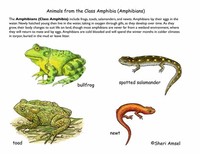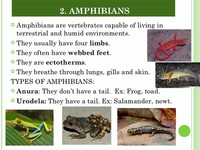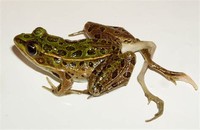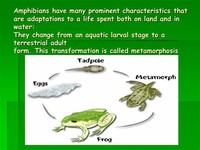Facts about Amphibian

Caecilians belong to the order Gymnophiona or Apoda ("without legs"), and are elongated, segmented amphibians, looking almost wormlike.

Larval amphibians are also consumers of insects, algae, and zooplankton in the aquatic environment.

Adult amphibians have three chambered hearts (larvae have two-chambered hearts) and usually two lungs.

The first record of amphibian-like animals in the fossil record is 360 to 390 million years ago, during the Devonian period.

Anurans have well developed voices, whereas the other two orders of amphibians are limited to sounds such as coughs and grunts.

Nutrients that have washed from the land into bodies of water via erosion can be recycled by amphibians as they enter the land after metamorphosis.

Clearly, beyond the practical need to preserve amphibian populations, humans have an ethical and moral responsibility to care for amphibians, as well as all species.

Occupying habitats in most parts of the world, amphibians play an important role in the balance of nature.

The specific relationship between the three orders of extant amphibians (anurans, caudates, and gymnophionas) represents one of the great controversies in vertebrate evolution.

Amphibians also lower the prevalence of insect-borne diseases by reducing the numbers of insects.

Amphibians play an important role in nutrient cycles and as environmental indicators.

Amphibian toxins, which aid in defense from predators and in prevention of bacterial and fungal growth on their skin, can serve as a medicinal drug for human use, when used in the correct dose.

Direct removal of amphibians likewise has resulted in intense pressure on populations.

Medicine produced from amphibians now is used to treat heart aliments, bacterial infections, skin and colon cancers, depression, and chronic pain, among others.

Frogs and toads differ from the other amphibian orders by the presence of larger hind limbs among the four limbs.

Frogs and toads are the most numerous and diverse amphibians, being found in nearly all habitats, including aboral, aquatic and terrestrial niches, and every continent except Antarctica.

The loss of amphibians have often correlated with population increases of insects, while the loss of amphibian larvae can also lead to algae blooms, low oxygen, and fish kills.

In balance, it should also be noted that only about one percent of amphibian species have experienced global declines (Beebee 1995).

The lower skin layer (dermis) of almost all amphibians has mucous glands, to provide moisture, and poison glands, to produce toxins.

By controlling insects, amphibians also help in reducing the threat to humans of insect-borne diseases.

The sparse fossil record, with the caecilians in particular having few fossil representatives—as well as the high degree of anatomical specialization of amphibian species—contributes to the difficulty in establishing phylogenetic relationships.

On the other hand, amphibians are also a food source for fish, birds, mammals, reptiles, and other amphibians.

Some ancestors of the tuba, such as the military bombardon, were wrapped such that the bell extended far backwards over the player's shoulder.

All amphibians belong to the class Amphibia of the Subphylum Vertebrata, of the Phylum Chordata or Craniata.

Amphibians are generally considered to be the first terrestrial vertebrates, and are thought to be descendant from fish ancestors.

Such amphibian declines are often perceived as one of the more critical threats to global biodiversity.

Both historically and presently, substances produced from amphibian glands offer an important source of medicine for humans.

Many of the causes of amphibian declines remain poorly understood, and amphibian declines are currently a topic of much ongoing research.

Lewis used the biphasic nature of amphibians as a metaphor for the human state: "Humans are amphibians: Half spirit and half animal.

Fish stocking has also harmed amphibian populations, as many amphibians cannot survive under such circumstances.

Being cold-blooded organisms, many amphibians enter a state of dormancy known under unfavorable conditions in the cold environment of winter as hibernation and during drought conditions in the summer as estivation.

The term "amphibian" comes from the Greek amphi meaning "both" and bios meaning "life," hence, "double life."

The fact that many amphibian toxins are similar to those that regulate human muscles and nerves contributes to their utility.

Amphibians range in size from the tiny Brachycephalus didactylus (Brazilian Gold Frog) and Eleutherodactylus iberia from Cuba, with a total length of 9.6–9.8 millimeters (0.4 inches), to the Chinese Giant Salamander mentioned above.

The ancient amphibians were considered to be typically larger than modern amphibians, with massive teeth, and some with scaled skin.

A highly diverse group of animals with only a core percentage exemplifying the most common defining characteristics, amphibians generally have smooth and naked skin.

Amphibians have two protusions on the back of the skull (occipital condyles) that articulate with the vertebra of the backbone, whereas reptiles have a single occipital condyle.

Amphibians have mastered almost every climate on earth from the hottest deserts to the frozen arctic.

A few tolerate brackish water, but there are no true sea water amphibians.

Caecilians are also the only amphibians with dermal scales; these scale-like structures are more similar to fish scales than reptile scales.

Most amphibians produce eggs without shells or membranes (amamniotic) that are deposited in water and rely on moisture from the surroundings.

Caecilians belong to the order Gymnophiona or Apoda ("without legs"), and are elongated, segmented amphibians, looking almost wormlike.
Reptiles include alligators, crocodiles, turtles, and snakes. Amphibians include salamanders, toads, and frogs. One difference between the two is the structure of their outer skin. Reptiles are covered with scales, shields, or plates, and their toes have claws.





